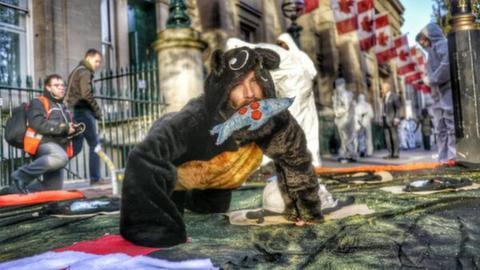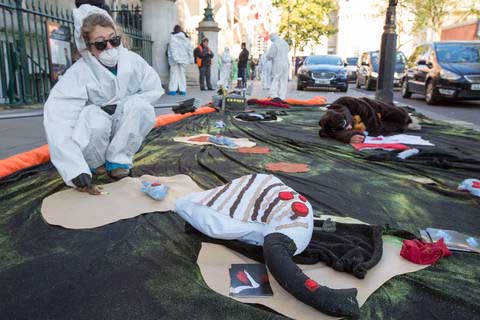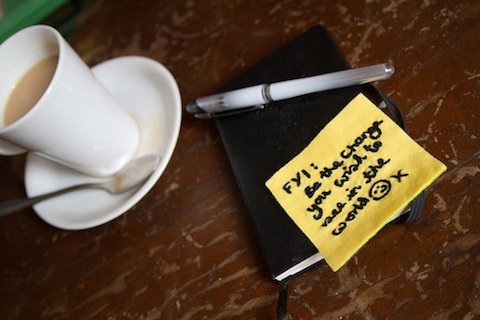
Betsy Greer was first to dream up the Craftivism moniker to describe the art of craft created for change and now she has come up with a bumper book detailing the many ways that people across the world have adopted this ideology. A must read for anyone interested in craft, activism and of course those who practice a combination of the two. I caught up with Betsy to find out how she got to here…

Carrie Reichardt: Public Community Mosaic on the front of the Treatment Rooms, London, 2012. Photo: Mark Baser
When and where did you first start practicing craftivism and how did it evolve at the start into something so much bigger?
In 2002, I started thinking about the connections between craft and activism and wrote about them privately on various craft forums online and on Livejournal. Thanks largely to the support I got from others, I began writing publicly about it in 2003. As I had been talking about it to individuals with similar interests, there was already a network of people around the world who knew about craftivism and could spread the word. At the time, it was fascinating to see how a word that was freshly coined was disseminated around the internet, because at first, its usage could always be traced back to someone I knew… When it was being used by complete strangers, I knew I was really onto something!

Tarlen Handayani: Knitting For Humanity. Let’s Knit Together for Mount Merapi Eruption Victims. (an event held at Tobucil & Klabs, a bookshop, info shop and community space in West Java, Indonesia) Photo: Tobucil & Klabs.
I love the idea that craftivism is about a change within as much as it is without, when did you first experience this realization?
When I started knitting in late 2000, I didn’t realize it at the time, but I was knitting myself through serious depression and working through various related problems. Knitting allowed me to sit with my feelings and process them in a way I had never been able to do before, because I was always the first off down the pub with friends. Knitting made me sit down and be still and not mask my problems with alcohol, eventually starting me on a path to better health.

Sian Lile-Pastore & Sara Huws: Contemporary Suffragette Banner 2013.
What kind of demonstrations and protests do you tend to get involved with on a personal level? Which causes do you feel the most personal connection to?
Most of my work has been focused on the war in a project that took international anti-war graffiti and turned it into cross stitch. The point of that project was not only to help deal with my own feelings of helplessness surrounding what was happening around the world, but also to remind people that there are individuals around the world that hold the same feelings that they do. I think sometimes we get so caught up in our own feelings that we forget that when it comes to world events, they are often universal.
At present, I am starting to do a few projects based on PTSD and its effects on mental health. After being given a diagnosis of PTSD in 2012 and realizing what a beast it was to handle, I started looking into ways to help other people deal with their own traumatic experiences. Along with trying to find a home for similar PhD research, I have been working on helping others deal with their own PTSD issues through needlework.
I felt a strong need to go down both these avenues not only because they gripped me emotionally, but because I felt that doing work around them might help others be able to more fully talk about the related issues, too. As I believe that craftivism is a great way to open dialogue, I use it as a stepping stone to foment conversation and understanding.

Mila Burcikova at work. Photo: Petra Lajdova Photography
How did you connect with the people who are featured in your book?
Initially, I sent out an email to people that I knew were working around craft and activism that told them about the book and asked if they would like to participate in it. I also asked if they knew anyone who might like to be included. From there, I was connected to other people from around the world that I might not have ever met. I filled in the cracks with some heavy Googling, which involved directly emailing people I didn’t know, telling them about the book, and asking them if they either would like to participate or knew of anyone who might. In not only asking people to participate, but also asking them about their network, I was able to discover some amazingly talented people, all of whom I couldn’t include in the book!

Extra-long ombre net made by Maria Molteni for the abandoned Bartlett Bus Yard Muralfest near Boston’s Dudley Square, 2013. Photo: Pat Falco
Do you have a favourite craft and if so what is it and why?
I tend to either knit, cross stitch, quilt, or embroider. I like them all pretty much the same and have quite a low skill level in each, when you consider I have been doing them for years. For me, the love and interest is in the process of doing the craft, the mindful meditation of it, instead of the mastery. In each of those crafts I can lose myself a bit in the rhythm of the stitching, which is both healing as well as exciting. I love the fact that I am literally healing myself by allowing myself to process emotions while also creating something to show the world at the same time.

Community Embroidery Canvas, Mini Maker Faire, 2012. (Part of a project at Mini Maker Faire Vancouver by Leanne Prain) Photo: Emily Smith
Are there certain crafts that you prefer to make in different situations and for different outcomes and experiences – and if so can you expand a bit on what they are?
I chose to do cross stitch for my international anti-war graffiti project because it almost forces the images to be pixelated, yet also very detailed. As war is something that we often see on tv alone, I liked that connection. I like knitting for the way it allows you to quickly whip up a project for donation. I like embroidery for its free form, yet precise detail when I’m working on something that needs it. I adore quilting by hand (through English paper piecing), although I’m barely past making simple blocks, because it just means following the lines and stitching things together. I love them all universally because they allow for me to create while also thinking about things.
Yarn bombing in particular is now a world wide phenomenon – why do you think it is has taken off in such a spectacular fashion?
I think it’s a combination of the internet becoming what it is, the ease and portability of knitting, and the clash of the seemingly quaint aspect of knitting and the urban environment. When you blend those things together, you not only get great visual moments to share photographically, you also get the sense that the place where you’re yarn bombing is just a little bit yours. In this, it can help people take back their cities as something without a personality and give them a voice.
What kind of making do you do to wind down? Is it any different to your craftivism?
I tend to do a lot of stitching and ripping out when I’m winding down really. Although it may seem a bit pointless on the surface, it helps me to see what works and what doesn’t. By making something that I don’t intend to show anyone else, I can freely experiment alone, which allows to be more confident in showing what I make at a later date.
Take a peek at Betsy Greer‘s website here, and buy Craftivism: The Art of Craft and Activism, published by Arsenal Pulp Press, here.
Categories ,activism, ,Arsenal Pulp Press, ,Betsy Greer, ,Carrie Reichardt, ,craft, ,Craftivism, ,Craftivism: The Art of Craft and Activism, ,Leanne Prain, ,Livejournal, ,Maria Molteni, ,Mila Burcikova, ,PTSD, ,Sara Huws, ,Sian Lile-Pastore, ,Tarlen Handayani
Similar Posts:
- A Little Book of Craftivism: an interview with Sarah Corbett
- The Craftivist Collective
- Emily Mackey
- Say It With Knit!
- Thereza Rowe, Hearts: interview and review

















